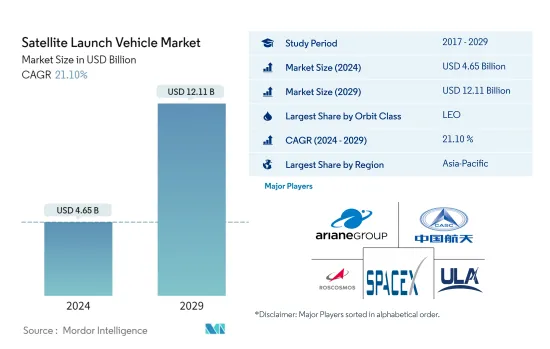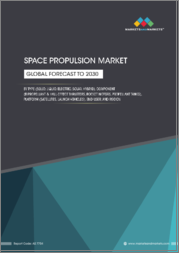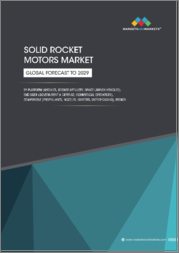
|
시장보고서
상품코드
1431658
세계 위성 발사체 시장 : 점유율 분석, 산업 동향과 통계, 성장 예측(2024년-2029년)Satellite Launch Vehicle - Market Share Analysis, Industry Trends & Statistics, Growth Forecasts (2024 - 2029) |
||||||
위성 발사체 시장 규모는 2024년에 46억 5,000만 달러로 추정되고, 2029년에는 121억 1,000만 달러에 이를 전망이며, 예측 기간 동안 복합 연간 성장률(CAGR) 21.10%로 성장할 전망입니다.

LEO 위성 수요가 이 분야의 성장을 견인
- 발사할 때 위성과 우주선은 대개 지구를 돌아 다니는 많은 특별한 궤도 중 하나에 배치됩니다. 또한 로켓 엔진이 추진하는 로켓을 사용하여 행성 간의 여행을 시작할 수 있습니다. 인공위성은 설계와 주요 목적에 따라 다양한 거리에서 지구를 돌립니다. 각각의 거리에는 커버 범위의 확대나 에너지 효율의 저하 등의 장점과 과제가 있습니다. 지구중궤도(MEO)에 있는 위성에는 특정 지역을 감시하도록 설계된 항법위성 및 특수위성이 포함됩니다. NASA의 지구관측 시스템을 포함한 대부분의 지구 과학 위성은 지구 저궤도(LEO)에 있습니다.
- 이러한 궤도에서 제조,발사되는 위성은 각각 용도가 다릅니다. 예를 들어, 2017년-2022년까지 거의 4,131대의 위성이 LEO에 배치되어 주로 통신과 지구관측에 중점을 두고 있습니다. MEO에서 발사된 57대의 위성의 대부분은 항법/전 지구 측위 목적으로 만들어졌습니다. 마찬가지로 GEO에 발사된 147대의 위성의 대부분은 통신과 지구관측을 목적으로 합니다.
- LEO는 그 가까이, 국제 우주 정거장(ISS)의 존재, 적도 경로를 따라야하는 강제력의 부족 등 다양한 장점에서 가장 일반적으로 사용되는 궤도입니다. 이 궤도에서 위성은 초당 약 7.8km의 속도로 이동하며 지구를 돌면서 약 90분이 걸립니다.
- 전자정보, 지구과학, 레이저영상처리, 전자정보, 광학화상처리, 기상학 등의 분야에서 위성의 이용이 증가하고 있기 때문에 로켓 수요의 견인역이 될 것으로 예상됩니다. 이 시장은 2029년에는 210%의 성장이 예상되며, 2023년에 기록된 금액을 상회합니다.
2029년에는 아시아태평양과 북미가 92%의 누적 점유율을 차지할 것으로 예상됩니다.
- 우주산업은 최근 놀라운 성장을 이루고 있으며, 수많은 기업들이 로켓 개발,배치의 주요 기업으로 대두하고 있습니다. 북미는 우주 탐사의 선구자이자 많은 우주 임무가이 지역으로 끝났습니다. SpaceX는 현재 Falcon-9, Falcon Heavy, Starship 등의 발사 로켓을 제공하며 이 지역의 발사 서비스를 선도하고 있습니다. 2017년부터 2022년에 걸쳐, 스페이스 X사의 로켓은 약 2,744기의 위성을 궤도에 발사했습니다.
- 유럽에서는 아리안 그룹과 같은 기업이 재사용 가능한 첫 번째 단계를 포함하는 알리안 넥스트로켓을 개발하고 있습니다. 러시아 로스 코스모스는 로켓 개발 및 배포의 오랜 역사를 가진이 업계에서 중요한 기업입니다. 이 회사는 서유즈 로켓과 양성자 로켓의 개발을 담당하고 다양한 위성을 우주로 발사했습니다. 2017년부터 2022년까지, 소유스 로켓은 세계 각종 위성 사업자들을 위해 약 611개의 위성을 우주로 발사했습니다.
- 아시아태평양에서 CASC는 세계에서 가장 신뢰할 수 있는 로켓 중 하나인 장정 로켓 시리즈를 포함한 다양한 로켓의 개발과 배포를 담당하고 있습니다. 2017년부터 2022년까지 CASC의 장정 로켓은 세계 각종 위성 사업자를 위해 약 372개의 위성을 우주로 발사했습니다. 한편 JAXA는 H-IIA 로켓과 H-IIB 로켓을 개발했습니다. 2017년부터 2022년까지, JAXA의 H-IIA 로켓은 세계 각종 위성 사업자들을 위해 약 25대의 위성을 우주로 발사했습니다. 2017년과 2022년 사이에 ISRO 로켓은 세계 각종 위성 사업자를 위해 약 171개의 위성을 우주로 발사했습니다.
세계 위성 발사체 시장 동향
세계 위성 발사체 시장 수요 증가와 경쟁
- 북미는 우주 탐사의 선구자이자 많은 우주 임무가이 지역으로 끝났습니다. SpaceX사는 북미를 대표하는 항공우주 기업으로 선진적인 재사용형 로켓과 우주선을 제조,발사하고 있습니다. 현재 Falcon-9, Falcon Heavy, Starship 등의 발사 로켓을 가지고 있으며, 이 지역에서 발사 서비스의 주요 공급자가 되고 있습니다. 2017년부터 2022년에 걸쳐, 스페이스 X사의 로켓은 약 2,744기의 위성을 궤도에 발사했습니다.
- 유럽에서는 아리안 그룹과 같은 기업이 아리안 로켓의 재사용 가능한 첫 번째 단계를 포함하는 아리안 넥스트로켓을 개발하고 있습니다. 러시아 로스 코스모스는 로켓 개발 및 배포의 오랜 역사를 가진이 시장의 중요한 선수입니다. 이 회사는 서유즈 로켓과 양성자 로켓의 개발을 담당하고 다양한 위성을 우주로 발사했습니다. 2017년부터 2022년까지, 소유스 로켓은 세계 각종 위성 사업자를 위해 약 611개의 위성을 우주로 발사했습니다.
- 아시아태평양에서 CASC는 세계에서 가장 신뢰할 수 있는 로켓 중 하나인 장정 로켓 시리즈를 포함한 다양한 로켓의 개발과 배포를 담당하고 있습니다. 2017년부터 2022년까지 CASC의 장정 로켓은 세계 각종 위성 사업자들을 위해 약 372개의 위성을 우주로 발사했습니다. 2017년부터 2022년까지, JAXA는 H-IIA 로켓과 H-IIB 로켓을 사용하여 세계 각종 위성 사업자를 위해 약 25개의 위성을 우주로 발사했습니다. 인도의 우주 프로그램도 최근 몇 년동안 큰 성장을 이루고 있으며, ISRO는 이 나라의 로켓 개발에 중요한 역할을 하고 있습니다. 2017년부터 2022년까지 ISRO의 로켓은 세계 다양한 위성 사업자들을 위해 약 171개의 위성을 우주로 발사했습니다.
세계 위성 발사체 시장의 투자 기회
- 북미에서는 우주 계획을 위한 세계 정부 지출이 2021년 과거 최고의 약 1,030억 달러에 달했습니다. 이 지역은 세계 최대의 우주 기관인 NASA가 존재하는 우주 혁신과 연구의 진원지입니다. 2022년 미국 정부는 우주 프로그램에 620억 달러 가까이를 소비하고 세계에서 가장 우주 개발에 자금을 투자하는 나라가 되었습니다. 발사 로켓 개발에 할당되는 자금에 관해서는 2023년도 대통령 예산 요구 개요(2022-2027년도) 하에서 NASA는 138억 달러를 받을 전망입니다.
- 2022년 11월 ESA는 22개국에 2023년부터 2025년까지 185억 유로의 예산을 요구했다고 발표했습니다. 39억 달러 미만의 비용으로 개발되었으며, 당초에는 2020년 7월 발사를 예정하고 있던 이 프로젝트는 잇따라 연기에 휩쓸리고 있습니다. 프랑스, 독일, 이탈리아의 3개국 정부는 유럽 우주에 대한 독립적인 접근을 보장하면서 유럽 로켓 경쟁력을 강화하기 위해 "유럽에서의 로켓 개발 미래"에 관한 협정에 서명했다고 발표했습니다. 했습니다.
- 2023년 2월 인도 정부는 ISRO가 다양한 우주 관련 활동을 위해 20억 달러를 받을 전망이라고 발표했습니다. 주요 계획에 대한 지출은 발사 활동, 로켓, 엔진, 위성 등의 연구 개발에 9,441 카롤 루피가 할당되었습니다. 2021년 3월 일본은 우주 관련 활동에 41억 4,000만 달러를 지출할 계획을 발표했습니다. 2023년 3월 한국은 차세대 경력 로켓 KSLV-2 개발에 약 1억 1,360만 달러를 사용한다고 발표했습니다.
위성 발사체 산업 개요
위성 발사체 시장은 상당히 통합되어 있으며 상위 5개사에서 160.48%를 차지하고 있습니다. 이 시장의 주요 기업은 알리안 그룹, 중국 항천과 기술 가랑 유한 공사(CASC), ROSCOSMOS, 스페이스 익스플로레이션 테크놀로지스 코퍼레이션, 유나이티드 런치 얼라이언스 LLC(알파벳순)입니다.
기타 혜택:
- 엑셀 형식 시장 예측(ME) 시트
- 3개월간의 애널리스트 서포트
목차
제1장 주요 요약과 주요 조사 결과
제2장 보고서 제안
제3장 소개
- 조사의 전제조건과 시장 정의
- 조사 범위
- 조사 방법
제4장 주요 산업 동향
- 위성의 소형화
- 로켓의 소유자
- 우주 개발에의 지출
- 규제 프레임워크
- 세계
- 호주
- 브라질
- 캐나다
- 중국
- 프랑스
- 독일
- 인도
- 이란
- 일본
- 뉴질랜드
- 러시아
- 싱가포르
- 한국
- 아랍에미리트(UAE)
- 영국
- 미국
- 밸류체인과 유통채널 분석
제5장 시장 세분화
- 궤도 클래스
- GEO
- LEO
- MEO
- 로켓
- 헤비
- 행성간
- 라이트
- 중형
- 발사 지역
- 아시아태평양
- 국가별
- 중국
- 인도
- 뉴질랜드
- 유럽
- 국가별
- 러시아
- 북미
- 국가별
- 미국
- 세계 기타 지역
- 국가별
- 이란
- 세계 기타 지역
- 아시아태평양
제6장 경쟁 구도
- 주요 전략적 움직임
- 시장 점유율 분석
- 기업 상황
- 기업 프로파일
- Ariane Group
- China Aerospace Science and Technology Corporation(CASC)
- Indian Space Research Organisation(ISRO)
- Mitsubishi Heavy Industries
- Northrop Grumman Corporation
- ROSCOSMOS
- Space Exploration Technologies Corp.
- SpaceX
- The Boeing Company
- United Launch Alliance, LLC.
제7장 CEO에 대한 주요 전략적 질문
제8장 부록
BJH 24.03.05The Satellite Launch Vehicle Market size is estimated at USD 4.65 billion in 2024, and is expected to reach USD 12.11 billion by 2029, growing at a CAGR of 21.10% during the forecast period (2024-2029).

The demand for LEO satellites is driving the segment's growth
- During the launch, a satellite or spacecraft is usually placed into one of many special orbits around the Earth. It can also be launched into an interplanetary journey using a launch vehicle propelled by rocket engines. Satellites orbit the Earth at varying distances depending on their design and primary purpose. Each distance has its own benefits and challenges, including increased coverage and decreased energy efficiency. Satellites in medium Earth orbit (MEO) include navigational and specialized satellites designed to monitor a specific area. Most Earth science satellites, including NASA's Earth Observation System, are in low Earth orbit (LEO).
- Different satellites manufactured and launched in these orbits have different applications. For instance, from 2017 to 2022, almost 4,131 satellites were deployed in LEO, focusing mainly on communication and Earth observation. Most of the 57 satellites launched in MEO were built for navigation/global positioning purposes. Similarly, most of the 147 satellites in GEO were deployed for communication and Earth observation purposes.
- LEO is the most commonly used orbit due to its various advantages, such as close proximity, the presence of the International Space Station (ISS), and no compulsion to follow the equator path. In this orbit, satellites travel at a speed of around 7.8 km per second and take approximately 90 minutes to circle Earth, meaning the ISS travels around Earth about 16 times a day.
- The increasing usage of satellites in areas such as electronic intelligence, Earth science, laser imaging, electronic intelligence, optical imaging, and meteorology is expected to drive the demand for launch vehicles. The market is expected to grow by 210% in 2029, outpacing the amount recorded in 2023.
Asia-Pacific and North America are expected to occupy a major cumulative share of 92% in 2029
- The space industry has seen remarkable growth in recent years, with numerous companies emerging as major players in the development and deployment of launch vehicles. North America has been a pioneer in space exploration, with many space missions having their origins in the region. SpaceX is currently the leading provider of launch services in the region, with its launch vehicles including Falcon-9, Falcon Heavy, and Starship. During 2017-2022 SpaceX's rockets launched approximately 2,744 satellites into orbit.
- In Europe, companies like ArianeGroup are developing the Ariane Next rockets, including a reusable first stage. Russia's Roscosmos is another key player in the industry, with a long history of developing and deploying launch vehicles. The company is responsible for developing the Soyuz and Proton rockets, which have been used to launch a range of satellites into space. During 2017-2022, the Soyuz rocket launched approximately 611 satellites into space for various satellite operators globally.
- In Asia-Pacific, CASC is responsible for developing and deploying a range of launch vehicles, including the Long March series, which has become one of the most reliable launch vehicles in the world. During 2017-2022, CASC's Long March rocket launched approximately 372 satellites into space for various satellite operators globally. JAXA, on the other hand, has developed H-IIA and H-IIB rockets. During 2017-2022, JAXA's H-IIA rockets launched approximately 25 satellites into space for various satellite operators globally. During 2017-2022, ISRO's rockets launched approximately 171 satellites into space for various satellite operators globally.
Global Satellite Launch Vehicle Market Trends
Growing demand and competition in the global satellite launch vehicle market
- North America has been a pioneer in space exploration, with many space missions having their origins in the region. SpaceX is a leading aerospace company in North America that manufactures and launches advanced reusable rockets and spacecraft. It is currently the leading provider of launch services in the region, with its launch vehicles including Falcon-9, Falcon Heavy, and Starship. During 2017-2022, SpaceX's rockets launched approximately 2,744 satellites into orbit.
- In Europe, companies such as ArianeGroup are developing the Ariane Next rockets, which involve a reusable first stage for the Ariane rocket. Russia's Roscosmos is another key player in the market, with a long history of developing and deploying launch vehicles. The company is responsible for the development of the Soyuz and Proton rockets, which have been used to launch a range of satellites into space. During 2017-2022, the Soyuz rocket launched approximately 611 satellites into space for various satellite operators globally.
- In Asia-Pacific, CASC is responsible for developing and deploying a range of launch vehicles, including the Long March series, which has become one of the most reliable launch vehicles in the world. During 2017-2022, CASC's Long March rocket launched approximately 372 satellites into space for various satellite operators globally. During 2017-2022, JAXA launched approximately 25 satellites into space for various satellite operators globally using its H-IIA and H-IIB rockets. India's space program has also seen significant growth in recent years, with the ISRO playing a key role in the development of the country's launch vehicles. During 2017-2022, ISRO's rockets launched approximately 171 satellites into space for various satellite operators globally.
Investment opportunities in the global satellite launch vehicle market
- In North America, global government expenditure for space programs hit a record of approximately USD 103 billion in 2021. The region is the epicenter of space innovation and research, with the presence of the world's biggest space agency, NASA. In 2022, the US government spent nearly USD 62 billion on its space programs, making it the highest spender on space in the world. In terms of funds allocated for launch vehicle development, under FY 2023 President's Budget Request Summary from FY 2022-FY 2027, NASA is expected to receive USD 13.8 billion.
- In November 2022, ESA announced that it had asked its 22 nations to back a budget of EUR 18.5 billion for 2023-2025, with Germany, France, and Italy being the major contributors. Developed at a cost of just under USD 3.9 billion and originally set for an inaugural launch in July 2020, the project has been hit by a series of delays. The governments of France, Germany, and Italy announced that they had signed an agreement on "the future of launcher exploitation in Europe" to enhance the competitiveness of European vehicles while ensuring independent European access to space.
- In February 2023, the Indian government announced that ISRO is expected to receive USD 2 billion for various space-related activities. Under the Outlay on Major Schemes, INR 9,441 crore has been allocated for launch activity, R&D on rockets, engines, satellites, etc. In March 2021, Japan announced its plan to spend USD 4.14 billion on space-related activities. In March 2023, South Korea announced that approximately USD 113.6 million would be used to develop a next-generation carrier rocket, the KSLV-2.
Satellite Launch Vehicle Industry Overview
The Satellite Launch Vehicle Market is fairly consolidated, with the top five companies occupying 160.48%. The major players in this market are Ariane Group, China Aerospace Science and Technology Corporation (CASC), ROSCOSMOS, Space Exploration Technologies Corp. and United Launch Alliance, LLC. (sorted alphabetically).
Additional Benefits:
- The market estimate (ME) sheet in Excel format
- 3 months of analyst support
TABLE OF CONTENTS
1 EXECUTIVE SUMMARY & KEY FINDINGS
2 REPORT OFFERS
3 INTRODUCTION
- 3.1 Study Assumptions & Market Definition
- 3.2 Scope of the Study
- 3.3 Research Methodology
4 KEY INDUSTRY TRENDS
- 4.1 Satellite Miniaturization
- 4.2 Owner Of Launch Vehicle
- 4.3 Spending On Space Programs
- 4.4 Regulatory Framework
- 4.4.1 Global
- 4.4.2 Australia
- 4.4.3 Brazil
- 4.4.4 Canada
- 4.4.5 China
- 4.4.6 France
- 4.4.7 Germany
- 4.4.8 India
- 4.4.9 Iran
- 4.4.10 Japan
- 4.4.11 New Zealand
- 4.4.12 Russia
- 4.4.13 Singapore
- 4.4.14 South Korea
- 4.4.15 United Arab Emirates
- 4.4.16 United Kingdom
- 4.4.17 United States
- 4.5 Value Chain & Distribution Channel Analysis
5 MARKET SEGMENTATION (includes market size in Value in USD, Forecasts up to 2029 and analysis of growth prospects)
- 5.1 Orbit Class
- 5.1.1 GEO
- 5.1.2 LEO
- 5.1.3 MEO
- 5.2 Launch Vehicle Mtow
- 5.2.1 Heavy
- 5.2.2 Inter Planetary
- 5.2.3 Light
- 5.2.4 Medium
- 5.3 Region
- 5.3.1 Asia-Pacific
- 5.3.1.1 By Country
- 5.3.1.1.1 China
- 5.3.1.1.2 India
- 5.3.1.1.3 New Zealand
- 5.3.2 Europe
- 5.3.2.1 By Country
- 5.3.2.1.1 Russia
- 5.3.3 North America
- 5.3.3.1 By Country
- 5.3.3.1.1 United States
- 5.3.4 Rest of World
- 5.3.4.1 By Country
- 5.3.4.1.1 Iran
- 5.3.4.1.2 Rest of World
- 5.3.1 Asia-Pacific
6 COMPETITIVE LANDSCAPE
- 6.1 Key Strategic Moves
- 6.2 Market Share Analysis
- 6.3 Company Landscape
- 6.4 Company Profiles (includes Global Level Overview, Market Level Overview, Core Business Segments, Financials, Headcount, Key Information, Market Rank, Market Share, Products and Services, and Analysis of Recent Developments).
- 6.4.1 Ariane Group
- 6.4.2 China Aerospace Science and Technology Corporation (CASC)
- 6.4.3 Indian Space Research Organisation (ISRO)
- 6.4.4 Mitsubishi Heavy Industries
- 6.4.5 Northrop Grumman Corporation
- 6.4.6 ROSCOSMOS
- 6.4.7 Space Exploration Technologies Corp.
- 6.4.8 SpaceX
- 6.4.9 The Boeing Company
- 6.4.10 United Launch Alliance, LLC.
7 KEY STRATEGIC QUESTIONS FOR SATELLITE CEOS
8 APPENDIX
- 8.1 Global Overview
- 8.1.1 Overview
- 8.1.2 Porter's Five Forces Framework
- 8.1.3 Global Value Chain Analysis
- 8.1.4 Market Dynamics (DROs)
- 8.2 Sources & References
- 8.3 List of Tables & Figures
- 8.4 Primary Insights
- 8.5 Data Pack
- 8.6 Glossary of Terms

















